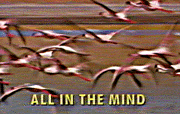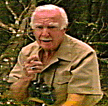________________
CM . . . .
Volume I Number XIII . . . . September 8, 1995

|
|
Apeman
Episode Three: It's All in the Mind
Arts & Entertainment Network. 52 minutes
Distributed as part of the Cable in the Classroom project: 7 - 8 a.m.
Eastern time, Friday September 15. (Episode Four will be broadcast at the
same time the following week.)
Grades 7 and up / Ages 12 and up.
Review by Duncan Thornton |

excerpt:
And to think that someone in what we now call Europe
fashioned (this figurine) from ivory tens of thousands of years ago. It's
just hard to grasp that when someone did this, no one had ever done it
before. I'm looking at something made by a person, made by someone
perhaps I could talk to. Someone basically like me.
 Cable in the Classroom is currently presenting A&E's series on the
development of the human species, Apeman. Hosted by Walter
Cronkite, Apeman is quality work, covering the basics of
the story without introducing unnecessary complexities or debates.
Cable in the Classroom is currently presenting A&E's series on the
development of the human species, Apeman. Hosted by Walter
Cronkite, Apeman is quality work, covering the basics of
the story without introducing unnecessary complexities or debates.
Episode Three, "It's All in the Mind," looks at hominid evolution,
concentrating on the development of the brain, and especially our
capacity for speech as the key to the emergence of modern human beings.
The style is a familiar one: Cronkite provides linking narration, themes,
and questions; experts from around the world provide information and
opinion; extras recreate scenes from pre-historic life; and paintings
illustrating parts of our past that would require too much in the way of
expensive special effects. The mix is handled well -- we are spared
watching people in fur suits stumping around and grunting; but we do see
unapologetically modern-looking actors recreating say, Neanderthal burial
practices.

Someone once said that pre-history was the playground of the
intellectual; it's easy to cast conjectures back in time that justify our
view of ourselves or of how we ought to be, but "It's All in the Mind"
avoids using the subject to beat any particular drum, taking a mainstream
approach to evolutionary history, and largely ignoring both the
complexities and controversies in the hominid record.

Too often the video uses Cronkite observing African tribal rituals
as stand-ins for pre-historic society, but the Neanderthal section (the
longest and most interesting part of the video) cleverly uses footage of
North American rodeo cowboys to illustrate some basic points:
Neanderthals had to be big and strong because they hunted large animals
by hand (they didn't have arrows or spears), and when they were injured
(in pretty much the same ways as rodeo cowboys are) they required care by
other members of the community. That compassion for others was a
necessary part of their society is reflected in the care that extending
after death: Neanderthals were the first humans to develop burial practices.
And what happened to these creatures so much like us, who lived
side-by-side with modern humans for tens of thousands of years? Here we
get the first real scientific debate, appropriately since this is a
matter of crucial concern: a human species that disappeared in the
recent past (only 35,000 years ago, a blink in the evolutionary scale!),
and the last of our hominid relatives to share the Earth with us. Did we
kill them off? Out-talk, out-breed, or out-think them? Or did we simply
absorb them into into our gene pool?

In any case, with the disappearance of the Neanderthals, the way is
clear for a quick look at the global explosion of modern humanity,
something made possible, of course, by our brains, our capacity for
complex communication and symbolic representation. Issues about the
nature of language and thought that Wittgenstein used to knot up many of
the finest minds of our century are, thankfully, glossed over, but some
of it is still a little pat. (For example, does learning how to make a
good arrow-head really require linguistic skill? It seems to me we learn
much by observation and imation that Apeman suggests comes from
instruction and communication.)
But in all, the video covers a vast topic skillfully and
intelligently; it's consistently absorbing and never confusing. An
excellent introduction for younger viewers, and a useful resource or
discussion-starter for senior students. As a sample of the sort of
viewing Cable in the Classroom will be providing, Apeman is
very promising, and it bodes well for the next series in their regular
Friday Archaeology slot, The Face of Tutankhamon.
(And the problems that expansion in numbers, societal complexity,
and technology has brought? That's Episode Four, reviewed next week.)

Highly Recommended.
Duncan Thornton is the Editor of Canadian Materials.

To comment on this title or this review, send mail to cm@umanitoba.ca.
Copyright © 1998 the Manitoba Library Association.
Reproduction for personal use is permitted only if this copyright notice
is maintained. Any other reproduction is prohibited without
permission.
Published by
The Manitoba Library Association
ISSN 1201-9364
TABLE OF CONTENTS FOR THIS ISSUE - September 8, 1995.
AUTHORS |
TITLES |
MEDIA REVIEWS |
BACK ISSUES |
SEARCH |
ORDER |
CMARCHIVE |
HOME



 Cable in the Classroom is currently presenting A&E's series on the
development of the human species, Apeman. Hosted by Walter
Cronkite, Apeman is quality work, covering the basics of
the story without introducing unnecessary complexities or debates.
Cable in the Classroom is currently presenting A&E's series on the
development of the human species, Apeman. Hosted by Walter
Cronkite, Apeman is quality work, covering the basics of
the story without introducing unnecessary complexities or debates.



